Form 2: Buddha's Warrior Attendant Pounds Mortar
1) Turn the upper body to the left slightly and shift the weight on the right leg. Turn both palms in a clockwise direction and raise the arms so that the left hand has the palm facing outward and is located above the left knee at eye level. The right hand palm, facing up, is in front of the chest on the centre line of the body. Eyes look forward and left. (Figure 4-5)
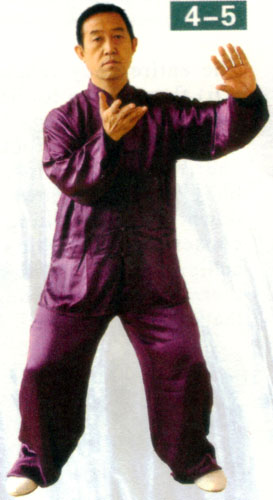
Key Requirements to the Movement:
Whilst turning the body and moving both palms up, relax and sink the hips. Coordinate the hips and the waist to utilize their combined strength and let this strength extend to both palms. Breathe in during this movement. Click here to learn Lumbago in TCM.
2) Move the body weight onto the left leg and relax the left hip, turn the hands in a counter clockwise direction so that the left palm changes to face diagonally upwards and the right palm changes to face outwards. Turn the body 90 degrees to the right, lifting the toes of the right foot. At the same time, the hands follow the body movement towards the right. Eyes look forward. Breathe out during this movement. (Figure 4-6)
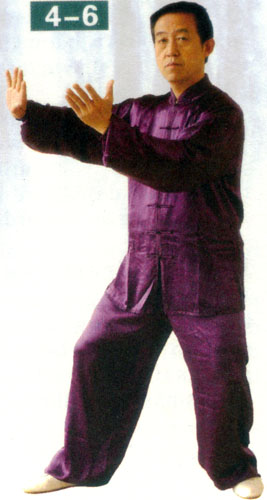
3) Sink and shift the weight onto the right leg and lift the left foot up with the knee bent. Bend the right knee and relax the hip, the upper body sinks down and turns to the right, both palms keep pushing upward and outward; eyes look left forward. (Figure 4-7)
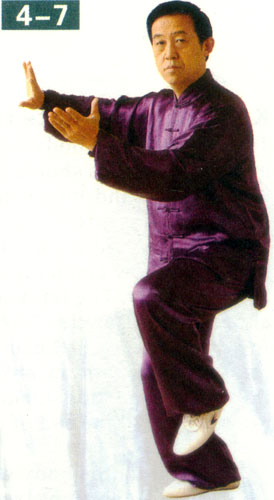
Key Requirements to the Movement:
Sinking the upper body must be coordinated with lifting the left foot. Don't bend the waist and protrude the buttocks. Breathe in during this movement.
4) Move the left foot out forward left with the heel sliding along the floor, the toes lifted up and turned inward. Keep the weight on the right leg with both palms pushing to the rear-right, in an upward and outward direction. Transfer the weight from the right leg onto the left leg. The whole left foot is placed on the floor with the toes turned outward slightly. (Figure 4-8) Eyes look to the left and forward.
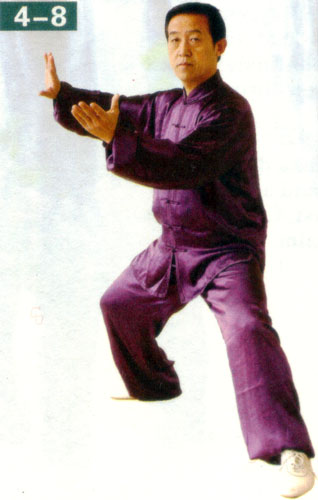
Key Requirements to the Movement:
Keep the torso upright whilst the left foot slides diagonally forward, both palms push diagonally toward the back right. This forms a cross coordinated line of strength. Breathe out during this movement.
5) Whilst transferring the weight, turn the upper body to the left about 45 degrees, both palms move down and forward in an arc with both arms rotating clockwise. The left palm moves to the front of the left side of the chest, with the elbow bent and the palm facing downward. The right palm moves down in front of the right leg above the knee, with the palm facing outward and fingers pointing behind. Eyes look forward. (Figure 4-9)
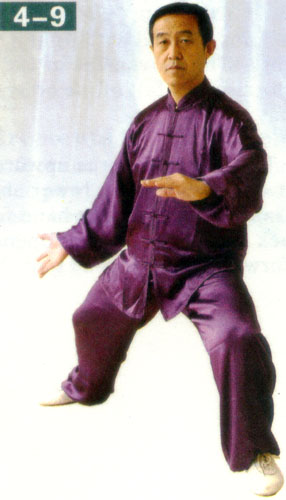
Key Requirements to the Movement:
Turning of the body, shifting the weight and moving the palms should be coordinated. Keep the pelvis down and move the hips forward. The left arm maintains a circular structure and keeps the "Peng" (outward push) strength throughout. Keep the right elbow about eight to ten centimeters away from the body. The left knee should align vertically above the left ankle. Do not let the knee protrude forward. The right knee is bent and the hips are relaxed. Maintain an arched structure to the legs throughout the movement. Breathe in at the beginning and out at the end of this movement. Click here to learn Degenerative Arthritis in TCM.
6) Keeping the body weight on the left leg, step (move) the right leg forward placing the toes on the ground to create an "empty stance" (no weight on the right leg). At the same time, the right hand follows the right leg in a forward rising arc with the palm facing upward in front of the right side of the chest. The fingers of the left hand lightly touch the right forearm. Eyes look forward. (Figure 4-10)
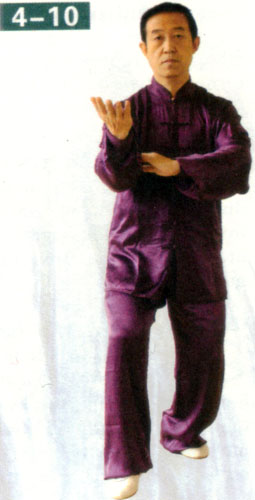
Key Requirements to the Movement:
The right foot steps forward with the knees bent and the hips relaxed with light, flexible and natural footwork. The movement of the arms coordinates with the rise and fall of the body. Breathe in during this movement.
7) The left palm turns upwards and sinks down to the front of the lower abdomen, and at the same time, the right hand forms a fist. Lower the back of the fist into the opened left palm. Eyes look forward. (Figure 4-11)

Key Requirements to the Movement:
Keep both hands and the abdomen about eight to ten centimeters apart, both arms hold a feeling of rounded outward "Peng" strength. The waist sinks down as the fist lowers into the left palm. Breathe out during this movement. Click here to learn Tuberculous Lymphadenitis in TCM.
8) Raise the right fist up to shoulder level in front of the body, and at the same time, lift the right knee whilst maintaining relaxed hips and a bent left knee. The right toes point naturally downward and the lower leg is turned slightly inward to a position close to the left knee. Eyes look forward. (Figure 4-12)
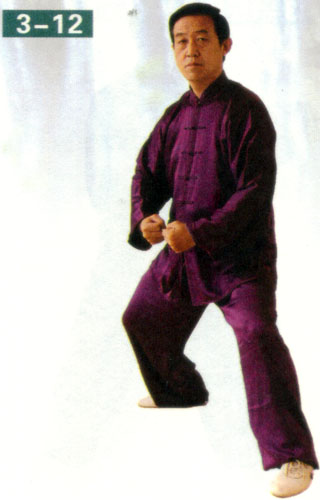
Key Requirements to the Movement:
As the right hand and foot rise up, the left side sinks down. (One side of the body is in Yin, the other is in Yang.) Do not rise up on the supporting leg as the right knee lifts. The internal energy flows down along the body. As the fist rises, the shoulders stay relaxed and the right elbow is dropped down. Breathe in during this movement. Click here to learn Frozen Shoulder in TCM.
9) Stamp the right foot on the floor about shoulder width apart from left foot and place it firmly on the floor. At the same time, the back of the right fist strikes downward onto the centre of the left palm, both arms are bent and maintain a feeling of rounded outward "Peng" strength. Eyes look forward. (Figure 4-13)
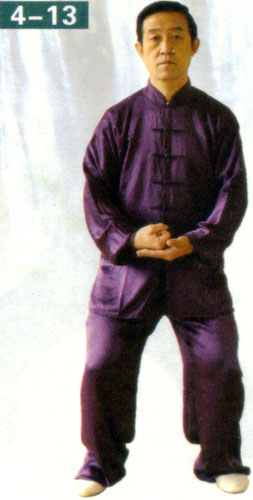
Key Requirements to the Movement:
Stamping the foot and pounding the right fist is a coordinated power releasing movement. Keep the knees bent and hips relaxed. The internal energy flows down to the Dantian. Breathe out during this movement.

![Diseases, Symptoms, tcm, [tcmwindow.com]](/uploadFile/adImg/2015/4/24/6de633b8-0a7a-4546-868a-02389edf5c65.png)





